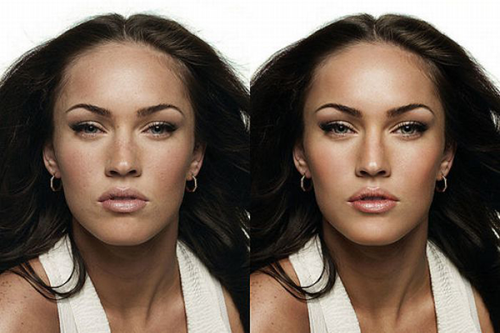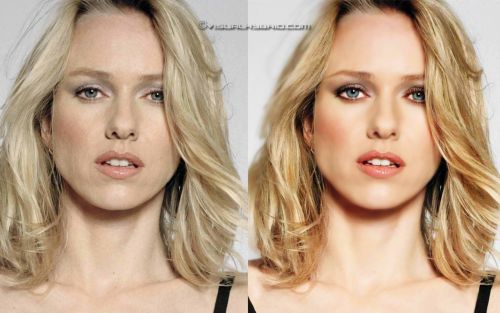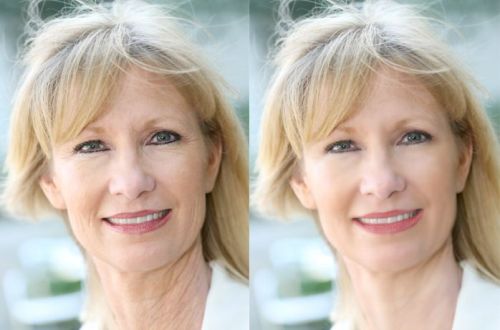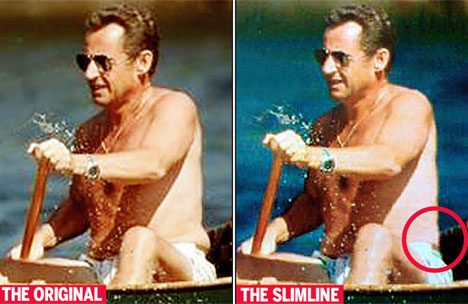
This is my reminder never to feel inadequate when you look at photos of "perfect" people.
because perfection is never real.
Whether it is heavy airbrushing, zapping zits, brightening eyes, contouring or more aggressively removing some unwanted back fat and pushing the eyes two inches apart so that the face appears more doll like- it happens.
Images are nipped and tucked and shaded and brightened and trimmed and filled out and flattened and rounded and smoothed, down to the last hair on the stomach and the veins in the hands. In the end, we see a reflection of someone not even the model can claim as their own.
Cindy Crawford once stated that she wished she looked as good as her photos do.
Magazines that run these doctored shots believe it gives them an air of exclusivity or originality, but sometimes they are shown as the fakes they are and even the celebrities seem to be fighting back. There are some ads and covers that really push the pixels on a photo and others that do it with a more subtle approach. Either way, this altering is deceptive.
A group of doctors and academics in the UK have submitted a report to the U.K.'s Advertising Standards Authority, saying retouched images make people as young as five hate themselves. They want disclaimers on ads. And understandably so.
The danger is clear: these are the role models we have set up to emulate. This is what we agree that beauty should look like. The problem is, that standard is unattainable, even for those held up as examples. According to a study only 2% of women consider themselves beautiful.
Below are 120 startling "before and after photoshop" photos, proving that perfection is never real, and compels one to ask, "why is this common practice," and "should it be illegal?" or at least require disclaimers on the images. In addition, it makes one question whether we should change what defines perfection. Ideally, the photoshopped images below are the ones deeply flawed.
Good News!
LIZZI MILLER- Glamour learned an important lesson in September 2009: normal women can sell magazines. They featured a photo of this woman seen below who is a 20-year-old model named Lizzi Miller, a size 12-14. an avid softball player/belly dancer, who moved to New York City from San Jose to become a model.
The reactions reported by Glamour in the piece, The Picture You Can't Stop Talking About: Meet "the Woman on p. 194" were incredibly positive and encouraging, proving that magazines don't need to sell eating disorders, distorted body images or photoshop versions of femininity, but that real women of all shapes can be seen as beautiful - and profitable for magazines who choose to feature them.
JAMIE LEE CURTIS- Actress Jamie Lee Curtis, who seven years ago stripped to her underwear at 43 - without the aid of an airbrush - to prove that even a woman who was once Hollywood's pin-up girl had matured to have as many lumps and bumps as the rest of us.
JESSICA SIMPSON- shows off her fresh face on the cover of Marie Claire magazine’s May 2010 issue. “I don’t have anything to prove anymore,” the 29-year-old singer shared. “What other people think of me is not my business.” Jess, who went without makeup and unretouched, is starting a new initiative called “A Beautiful Me,” which encourages young women to feel comfortable in their own skin and love themselves for who they are.
RACHAEL LEIGH COOK Quote- “I did not grow up getting told about how manipulated the images we see of women and girls out there are, and I think it’s an absolute travesty that young women are seeing what the media is feeding them,” Cook told Pop Tarts. “It breaks my heart to be part of an industry and part of a machine that really pushes out these images and propagates these really terrible standards that are false.” The “She’s All That” star is now not only urging youth to go online and Google “Photoshop Tutorial” to learn exactly what experts do to the images of all the celebrities and models out there, but she also wants the American public to know that even papparazi snaps aren’t all they’re purported to be.
"Nothing that you see is real, even if you look at what looks like a candid photo of someone, anything can be done. It is false advertising and false advertising is a crime so why isn't this a crime? I'm just up in arms about it. People need to know that there are actual lenses that are put on cameras that make people stretched out. If you saw these actors in person, you wouldn't even recognize them as the people you see on TV. It's just all a complete illusion and maybe it should be viewed as art, the way that art isn't real. The way that a picture of a rose can be beautiful, but it's not a real rose."
DOVE CAMPAIGN FOR REAL BEAUTY-The Dove Campaign for Real Beauty was started after Dove conducted a global study on beauty. A World Report confirmed a hypothesis that the definition for beauty had narrowed and was impossible to attain. Dove found that: Just 12% are satisfied with their physical attractiveness, only 2% of women describe themselves as beautiful, 67% of all women withdrew from life-engaging activities due to feeling badly about their looks, 68% strongly agree that the media sets an unrealistic standard of beauty, 75% wish the media did a better job in portraying the diversity of women's physical attractiveness, including size and shape, across all ages.
For years, the beauty industry and media have been constantly reminding women of the ideal body standards that have been set in today’s society. The Dove Campaign for Real Beauty is to support Dove’s mission of making women of all shapes and sizes feel beautiful every day, while widening stereotypical views of beauty.
The Dove Campaign for Real Beauty is communicated to the public through a variety of print and television advertisements, a Web site, workshops and films.
DOVE EVOLUTION-VIDEO
DOVE PRO-AGE CAMPAIGN-VIDEO (this was banned)
THE PHOTOSHOP EFFECT-VIDEO
PART 2 and PART 3
KILLING US SOFTLY PT 1-VIDEO (must see!)
LAWS/BANS
FRANCE WANTS PHOTOSHOP LAWS
UK WANTS TO BAN PHOTOSHOP TO THOSE UNDER 16
CANADIAN RETAILER BANS RETOUCHING
DOVE PRO-AGE CAMPAIGN-VIDEO (this was banned)
THE PHOTOSHOP EFFECT-VIDEO
PART 2 and PART 3
KILLING US SOFTLY PT 1-VIDEO (must see!)
LAWS/BANS
FRANCE WANTS PHOTOSHOP LAWS
UK WANTS TO BAN PHOTOSHOP TO THOSE UNDER 16
CANADIAN RETAILER BANS RETOUCHING
My Picks





































































.jpg)




























































Tidak ada komentar:
Posting Komentar